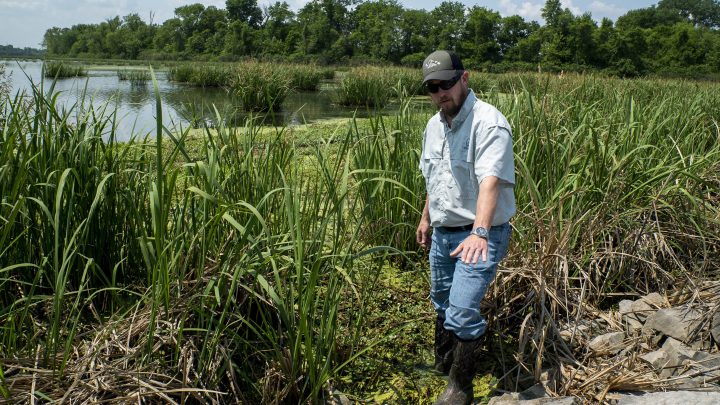
As Mississippi Riverfront development booms, wetlands become crucial to stave off flooding
As Mississippi Riverfront development booms, wetlands become crucial to stave off flooding

The Mississippi River has been having a bit of a moment.
“People all over the world want to come and see this iconic natural phenomenon that is the Mississippi,” said Colin Wellenkamp, executive director of the Mississippi River Cities and Towns Initiative. “It has a larger international following than the Grand Canyon.”
No longer is the nation’s largest river seen as only a corridor for commerce.
More and more, people want to interact with the Mississippi and the scenery along its 2,340 miles through activities like birding and canoeing, as well as parks and public spaces right next to the water, Wellenkamp said.
Communities up and down the river are eyeing multi-million dollar developments that tap into this desire and attract tourists and business.
But the cities Wellenkamp works with face one unavoidable problem: The Mississippi floods, and climate change is making those floods carry more water and last longer.
“So many of my cities have seen new projects wash away” when there’s too much water, Wellenkamp said.
And when there’s too little, those projects “get stuck in the mud, because the water is way out there in the channel because it’s a drought.”
After major flooding in 2019, his organization started focusing more on wetlands restoration to better manage the river’s water. One project is at a place called Rasky Slough and is about 10 miles northeast of the St. Louis Arch.
It’s 60 acres of tall grasses and shallow ponds surrounded by trees. Mike Sertle, who manages Mississippi wetlands restoration projects for Ducks Unlimited, spies egrets, great blue herons and other birds among the vegetation.
“You know you’re in a wetland or near a wetland when the redwings are around,” he said.
Sertle explained this slough can hold excess water during flooding and heavy rains. Water from Rasky flows back into the surrounding Horseshoe Lake, before eventually making its way back to the Mississippi.
“The goal is to mimic a natural system,” he said. “You want to dry it out every now and then, because it aerates the soil and we get a flush growth of vegetation.”
Those new plants suck up more water and provide habitat.
From start to finish, it cost about $250,000 to restore the wetland at Rasky Slough, but bigger projects can be more costly, Sertle said.
Ducks Unlimited is about to start a nearly 1,000-acre restoration a few miles to the west that’s right next to the Mississippi River. That project will likely cost between $5 million and $7 million, Sertle said.

“Investment in proper infrastructure in these wetlands systems, as we look [at] years of return, yeah we are seeing that it’s worth the upfront cost,” he said.
And the thing is, wetlands have already been effective this year to stem flooding from rapid spring snowmelt on the Upper Mississippi.
Take the city of La Crosse, Wisconsin. It just experienced the third highest flood on record, said La Crosse Mayor Mitch Reynolds. His city managed to avoid major damage with the help of wetlands, he said. New pumps helped move floodwaters from lower areas into nearby natural habitat.
“We’re lucky enough to have a marsh in the midst of the city that is basically our floodwater storage,” Reynolds said.
This experience has him and other mayors along the Mississippi leaning into the idea of having nature work for them, he said.
It reduces some of the risk that’s inherent with building right on the riverfront.
The financial institutions that offer loans on these projects are also paying attention, Wellenkamp said. Some have even given better interest rates on developments that preserve existing wetlands, he added.
“Why? Because the wetland creates a natural buffer to protect what we’re buying, what we’re paying for,” Wellenkamp said.
And that buffer means there’s less to worry about when the water starts to rise and more places to experience the natural river.
There’s a lot happening in the world. Through it all, Marketplace is here for you.
You rely on Marketplace to break down the world’s events and tell you how it affects you in a fact-based, approachable way. We rely on your financial support to keep making that possible.
Your donation today powers the independent journalism that you rely on. For just $5/month, you can help sustain Marketplace so we can keep reporting on the things that matter to you.


















